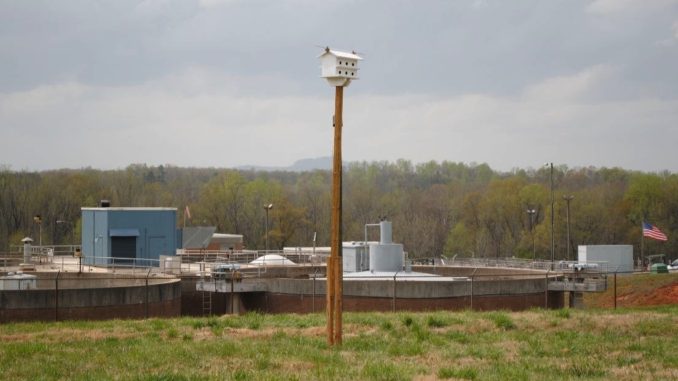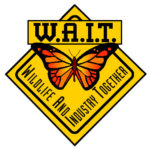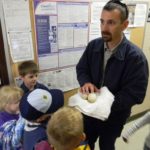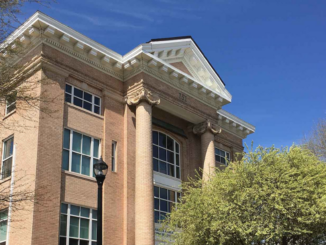
When you think of a wastewater treatment plant, you might not immediately think of wildflowers. Or  song birds. Or a flourishing habitat for native butterflies, bumblebees, reptiles and plants. So you may be surprised that the property surrounding Two Rivers’ Utilities three wastewater treatment plants provides a thriving environment that enriches the ecosystem and serves as a community resource.
song birds. Or a flourishing habitat for native butterflies, bumblebees, reptiles and plants. So you may be surprised that the property surrounding Two Rivers’ Utilities three wastewater treatment plants provides a thriving environment that enriches the ecosystem and serves as a community resource.
The commonly used term for wastewater is sewage and many people don’t want to live near a sewage treatment plant. Most people don’t want to live near industrial facilities, either. But it turns out that the land around quarries, factories, and facilities that produce energy or treat waste can be an excellent place for wildlife habitats.
In 2011, Two Rivers Utilities’ Wastewater Treatment Division joined the North Carolina Wildlife  Federation’s Wildlife and Industry Together program, often called WAIT. The WAIT sites are “dedicated areas on workplace grounds that are transformed into wildlife habitats that can sustain life for diverse wildlife species.”
Federation’s Wildlife and Industry Together program, often called WAIT. The WAIT sites are “dedicated areas on workplace grounds that are transformed into wildlife habitats that can sustain life for diverse wildlife species.”
It’s more than a feel-good program. Sites receive WAIT certification if they meet specific criteria for managing and maintaining the designated wildlife habitat to encourage native flora and fauna to flourish. Equally important is an educational component that involves employees and the community.
Forty sites around the state have attained WAIT certification, including TRU’s Crowders Creek Wastewater Treatment Plant, which was recognized in 2012. The Crowders Creek facility has a 2.4 acre wildflower meadow and an onsite library with books about native species and photos of wildlife seen at the site. TRU’s Long Creek and Eagle Road wastewater treatment plants are also participating and hope to attain WAIT certification next year.
Other WAIT-certified sites include the Carmel Country Club in Charlotte and the NC Museum of Art in Raleigh – meaning those chic locations have something in common with Gastonia’s Crowders Creek sewage treatment plant.
“We are really proud of the WAIT program” said Stephanie Scheringer, TRU division manager. “It’s an inexpensive but effective way to be partner with the community and enhance the environment.”
Education and tours
To help meet WAIT’s educational requirement, TRU offers tours of its wastewater treatment plants and  habitat areas. Most of those going on the tours are young people, such as with school groups and Scouts. In 2017, 224 community members toured a TRU wastewater treatment plant.
habitat areas. Most of those going on the tours are young people, such as with school groups and Scouts. In 2017, 224 community members toured a TRU wastewater treatment plant.
In addition to learning how wastewater is treated and cleaned, people on the tour visit the wildlife areas around the plants and get information about the WAIT program. TRU staff also provides information about the WAIT program when taking part in local school career fairs and presentations to the public.
Volunteers are essential to managing and improving TRU’s wildlife habitat sites. An Eagle Scout built and installed a hawk perch and purple martin condos. Gaston PAWS (Piedmont Area Wildlife Stewards) helped build wood duck boxes. A Charlotte Audubon Society member has conducted bird counts. Other community partners have donated flower seeds and educational supplies, and have maintained the meadows that provide cover for a wide range of native species.
Many TRU employees volunteer to assist with the on-site wildlife habitats, cleaning out bird boxes and  bat boxes, and helping maintain and enhance the habitat area. As they routinely check security of the plant perimeter, employees also keep a watch on the wildlife area, sometimes photographing the plants and animals they see.
bat boxes, and helping maintain and enhance the habitat area. As they routinely check security of the plant perimeter, employees also keep a watch on the wildlife area, sometimes photographing the plants and animals they see.
Scheringer says the WAIT program fits nicely with the Wastewater Treatment Division’s core mission of environmental protection, environmental stewardship and public education. “It’s been a positive for the staff,” Scheringer says. “We have many animal and nature lovers who enthusiastically volunteer to be part of the program.”
Since 2001, Two Rivers Utilities has operated as a certified ISO 14001, complying with international standards for effective management of environmental issues.



